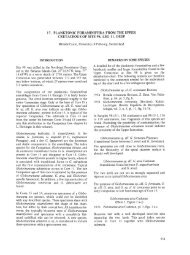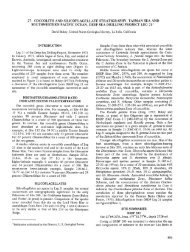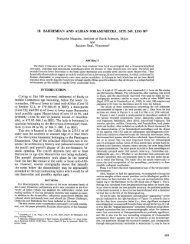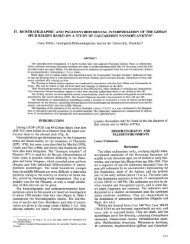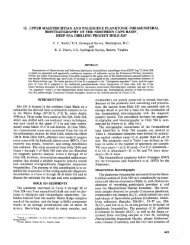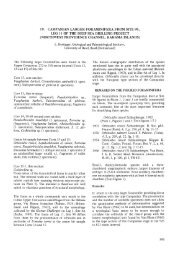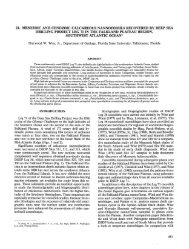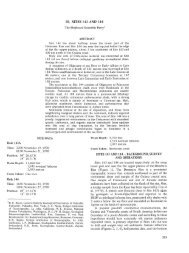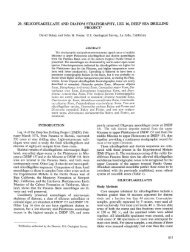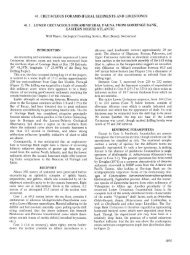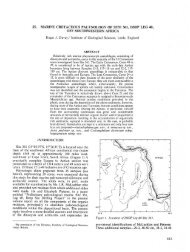16. Radiolaria - Deep Sea Drilling Project
16. Radiolaria - Deep Sea Drilling Project
16. Radiolaria - Deep Sea Drilling Project
You also want an ePaper? Increase the reach of your titles
YUMPU automatically turns print PDFs into web optimized ePapers that Google loves.
M. G. PETRUSHEVSKAYA, G. E. KOZLOVA<br />
Emended diagnosis. Skeleton is a biconvex lens. Central part<br />
represents by itself a sphere (hollow??). Sphere is surrounded in its<br />
equatorial plane by a thick ring composed of a dense pseudoaulophacoid<br />
meshwork.<br />
Dactyliosphaera sp. aff. Lithocyclia jüsta<br />
(Plate 3, Figure 16)<br />
1 Lithocyclia jüsta Rust, 1888, p. 197, pi. 24, fig. 6.<br />
Diameter of the whole skeleton about 150µ, of the central<br />
sphere 65-70µ. This species differs from typical L. jüsta Rust by the<br />
ratio of the dimensions of the sphere and ring.<br />
Cretaceous (Early Campanian).<br />
Family SPONGODISCIDAE Haeckel<br />
Spongodiscidae Haeckel, 1862, p. 452; Riedel, 1967b, p. 295.<br />
The skeleton, flattened along the main axis, consists of so-called<br />
spongy substance. It represents by itself small chambers. They are<br />
disposed irregularly or in a dense spiral, or in closely disposed<br />
spheres. The central chamber is usually not visible.<br />
Genus SPONGODISCUS Ehrenberg<br />
Spongodiscus Ehrenberg, 1854, p. 237; Haeckel, 1881, p. 461;<br />
1887, p. 567; Campbell, 1954, p. 93. Spongodisculus Haeckel,<br />
1887, p. 576; Campbell, 1954, p. 93. Type species Spongodiscus<br />
resurgens Ehrenberg.<br />
Spongodiscidae with discoid (lenticular) skeleton without arms<br />
or any other subdivisions. On the surface, a plate with small pores<br />
("gown") may be present. Very often there is a pylome. No strong<br />
outside radial spines.<br />
Spongodiscus resurgens Ehrenberg typ.<br />
(Plate 21, Figure 5)<br />
Spongodiscus resurgens Ehrenberg, 1854, pi. 35B, F, Fig. <strong>16.</strong><br />
Delicate spongy disc without gown, about lOOµ in diameter.<br />
Pylome tube is indistinct.<br />
Pliocene-Quaternary.<br />
Spongodiscus resurgens Ehrenberg osculσsa (Dreyer)<br />
(Plate 21, Figure 4)<br />
Spongopyle osculosa Dreyer, 1899, p. 42, figs. 99, 100; Riedel,<br />
1958, p. 226, pi. 1, fig. 12.<br />
Disc of the same delicate spongy structure as in S. resurgens typ.,<br />
190-270µ in diameter, very often with "gown". Pylome tube<br />
distinct.<br />
Middle Miocene-Recent (in Antaractic).<br />
In the Paleogene, Spongodiscus species existed with rougher,<br />
spongy, even lithelid, structure (Plate 21, Figures 1, 3).<br />
Genus SPONGOTROCHUS Haeckel<br />
Spongotrochus Haeckel, 1860, p. 844; 1887, p. 585; Campbell,<br />
1954, p. 94. = Spongotrochiscus Haeckel, 1862, p. 463; 1887, p.<br />
585; Campbell, 1954, p. 94. Type species Spongotrochus<br />
brevispinus Haeckel, 1862, pi. 27, figs. 4-5.<br />
Spongodiscidae with the flattened skeletal lens provided with<br />
numerous spines.<br />
Spongotrochus? spp.<br />
(Plate 3, Figure 4; Plate 5, Figures 11,12)<br />
Cretaceous (Maestrichtian),<br />
Spongotrochus? polygonatus Clark and Campbell<br />
(Plate 4, Figures 9, 10)<br />
Spongotrochus polygonatus Clark and Campbell, 1944b, p. 19, pi. 5,<br />
figs. 2, 10, 11<br />
Cretaceous (Campanian-Maestrichtian).<br />
Spongotrochus longispinus Haeckel<br />
(Plate 21, Figure 15)<br />
Spongotrochus longispinus Haeckel, 1887, p. 463, pi. 27, figs. 2, 3.<br />
Diameter of the disc about 200µ.<br />
Miocene-Quaternary.<br />
Genus SPONGOTRIPUS Haeckel<br />
Spongotripus Haeckel, 1881, p. 461; 1887, p. 580; Campbell, 1954,<br />
p. 94. Type species Spongotripus regularis Haeckel, 1887,<br />
unfigured.<br />
528<br />
Spongodiscidae with discoidal skeleton provided with three main<br />
spines.<br />
Cretaceous-Paleogene.<br />
Spongotripus morenoensis Campbell and Clark<br />
(Plate 6, Figures 2, 3)<br />
Spongotripus morenoensis Campbell and Clark, 1944b, p. 19, pi. 5,<br />
% I-<br />
Our specimens have somewhat greater dimensions than do<br />
specimens from Campbell and Clark's material.<br />
Cretaceous (Maestrichtian).<br />
Spongotripus sp.<br />
(Plate 21, Figure 2)<br />
This species is somewhat similar to Tripodictya triacantha<br />
Haeckel (1887, pi. 42, fig. 7), but it has a spongy skeleton, while in<br />
T. triacantha chambered rings are distinct.<br />
Eocene-Oligocene.<br />
Genus SPONGASTER Ehrenberg<br />
Spongaster Ehrenberg, 1860, p. 833; Haeckel, 1881, p. 462; 1887,<br />
p. 596; Campbell, 1954, p. 94; Riedel and Sanfilippo, 1970, p.<br />
522. Spongastrella Haeckel, 1887, p. 597; Campbell, 1954, p.<br />
94. Type species Spongaster tetras Ehrenberg.<br />
Schizodiscus Dogiel and Reshetnjak, 1952, p. 8. Type species<br />
Schizodiscus disymmetricus Dogiel (see pi. 21, fig. 14.).<br />
Spongodiscidae with discoidal skeleton without arms or spines.<br />
The spongy disc may be subdivided into one central and 4-6<br />
peripheral thick masses separated by thinner (more transparent)<br />
spongy bands (a kind of patagium?).<br />
Spongaster sp.<br />
(Plate 21, Figure 13)<br />
Elongated, nearly ellipsoidal Spongaster, somewhat similar to<br />
Spongurus sp. in Kruglikova, 1969, pi. 4, Fig. 33.<br />
Miocene.<br />
Genus OMMATOGRAMMA Ehrenberg<br />
Ommatogramma Ehrenberg, 1860; Haeckel, 1887, p. 519;<br />
Campbell, 1954, p. 88. Type species Ommatogramma naviculare<br />
Ehrenberg, 1872b, pi. 6, fig 7.<br />
Spongurus Haeckel, 1862, p. 465; 1881, p. 461; 1887, p. 343;<br />
Campbell, 1954, p. 74. Type species Spongurus cylindricus<br />
Haeckel, 1862, pi. 27, fig. 1.<br />
Spongocore Haeckel, 1887, p. 345; Campbell, 1954, p. 74. =<br />
Spongocorina Haeckel, 1887, p. 345; Campbell, 1954, p. 74.<br />
Type species Spongocore velata Haeckel, 1887, not illustrated.<br />
Spongocorisca Haeckel, 1887, p. 345; Campbell, 1954, p. 74. Type<br />
species Spongocore puella Haeckel, 1887, pi. 48, fig. 6.<br />
Spongodiscidae with nearly cylindrical (constricted) skeleton,<br />
often surrounded by a patagium.<br />
Ommatogramma sp. aff. Amphibrachium robustum Vinassa<br />
(Plate 21, Figure 10)<br />
1Amphibrachium robustum Vinassa, 1900, p. 577, pi. 2, fig. 11.<br />
Differs from O. puella (Hck.) in greater dimensions, and stronger<br />
spines extending from the middle part of the skeleton.<br />
Miocene-Quaternary.<br />
Genus RHOPALASTRUM Ehrenberg<br />
Rhopalastrum Ehrenberg, 1847b, p. 54; Haeckel, 1887, p. 526;<br />
Campbell, 1954, p. 88. = Rhopalastrella Haeckel, 1887, p. 526;<br />
Campbell, p. 88. Type species Rhopalastrum lagenosum Ehrenberg,<br />
1847, in 1854, pi. 22, fig. 22.<br />
Rhopalodictyum Ehrenberg 1860, p. 830; Haeckel, 1887, p. 589;<br />
Campbell, 1954, p. 94. Type species Rhopalodictyum abyssorum<br />
Ehrenberg, 1872b, pi. 8, fig. 17.<br />
Dictyocoryne Ehrenberg, 1860, p. 830; Haeckel, 1887, p. 592;<br />
Campbell, 1954, p. 94. Type species Dictyocoryne profunda<br />
Ehrenberg, 1872b, pi. 7, fig. 23.<br />
Dictyastrum Ehrenberg 1860, p. 830; Haeckel, 1887, p. 524;<br />
Campbell, 1954, p. 86. - Dictyastrella Haeckel, 1887, p. 524;<br />
Campbell, 1954, p. 86. Type species Dictyastrum angulatum<br />
Ehrenberg, 1872b, pi. 8, fig. 18.



